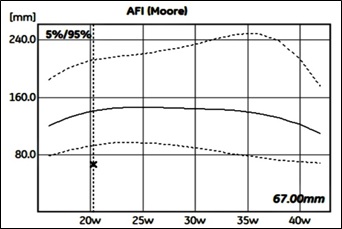Trisomy 13 mosaicism syndrome with atypical plurimalformative phenotype
Abstract
Introduction: Orofacial clefts are important congenital malformations of the lip, palate, or both caused by complex genetic and environmental factors. Aims and
Objectives: The present study aims to highlight the phenotypic heterogeneity of trisomy 13 mosaicism.
Material and Methods: We present one clinical case of a 30-year-old, Caucasian woman who is pregnant for the first time.
Techniques of work study: anamnesis, clinical examination, serological tests for Toxoplasmosis, Rubeola, CMV and Herpes, ultrasound examination at 20 weeks gestation with General Electric Echographe Voluson E10 BT18, amniocentesis, fetal chromosome analysis and genetic counseling.
Results: Ultrasound examination showed a viable singleton fetus with intra-uterine growth restriction, oligohydramnios, bilateral cleft lip and cleft palate, hypoplastic nasal bone and bilateral polycystic kidneys. Amniocentesis was done, and the fetal chromosomal analysis revealed a fetus with 46, XY/47, XY,+13 mosaic karyotype. After a complex genetic counselling the parents opted, to terminate the pregnancy. The autopsy confirm the prenatal ultrasound diagnosis.
Conclusion: Routine ultrasound examination during pregnancy and specific genetic testing are essential for the early prenatal detection of major structural fetal anomalies associated with rare genetic chromosome syndromes.
Downloads
References
Agbenorku P. Orofacial clefts: a worldwide review of the problem. ISRN Plastic Surg. 2013;2013. https://doi.org/10.5402/2013/348465.
Wehby GL, Murray JC. Folic acid and orofacial clefts: a review of the evidence. Oral Dis. 2010;16(1):11-19. doi: https://doi.org/10.1111/j.1601-0825.2009.01587.x.
Gómez O, Puerto B. Cleft Lip and Palate, in Obstetric Imaging: Fetal Diagnosis and Care (2nd Ed), 2018, doi: https://dx.doi.org/10.1016/C2014-0-00100-1.
Chang WJ, See LC, Lo LJ. Time trend of incidence rates of cleft lip/palate in Taiwan from 1994 to 2013. Biomed J. 2016;39(2):150-154. doi: https://doi.org/10.1016/j.bj.2015.10.003. Epub 2016 Jun 1.
Zegan G, Lesner G. [The characteristics of orofacial clefts in small communities]. Rev Med Chir Soc Med Nat Iasi. 2012;116(2):605-610.
Kouskoura T, Fragou N, Alexiou M, John N, Sommer L, Graf D, et al. The genetic basis of craniofacial and dental abnormalities. Schweiz Monatsschr Zahnmed. 2011; 121(7-8):636-646.
Stanier P, Moore GE. Genetics of cleft lip and palate: syndromic genes contribute to the incidence of non-syndromic clefts. Hum Mol Genet. 2004;13(1):R73-R81. Epub 2004 Jan 13. doi: https://doi.org/10.1093/hmg/ddh052.
Albu DF, Albu CC, Albu SD. Importance of ultrasound investigation in the early prenatal diagnosis of an Oral-Facial-Digital Syndrome Type I: a new case report. Int J Med Res Rev 2016;4(1):118-121. doi:10.17511/ijmrr.2016.i01.018.
Leslie EJ, Marazita ML. Genetics of cleft lip and cleft palate. Am J Med Genet C Semin Med Genet. 2013;163C (4):246-258.doi: https://doi.org/10.1002/ajmg.c.31381. Epub 2013 Oct 4
Tenconi RO, Clementi MA, Turolla LI. Theoretical recurrence risks for cleft lip derived from a population of consecutive newborns. J Med Genet. 1988;25(4):243-246. doi: http://dx.doi.org/10.1136/jmg.25.4.243.
Kot M, Kruk-Jeromini J. Analysis of family incidence of cleft lip and/or palate. Med Sci Monit. 2007; 13(5):CR231-C234.
Ion G, Albu CC, Albu SD, Albu DF. The benefits of prenatal testing associated with oral and maxillofacial pathology: new case report. EJBPS, 2017;4(4):670-673.
Gritli-Linde A. The etiopathogenesis of cleft lip and cleft palate: usefulness and caveats of mouse models. Curr Top Dev Biol. 2008;84:37-138. doi: https://doi.org/10.1016/S0070-2153(08)00602-9.
Jugessur A, Farlie PG, Kilpatrick N. The genetics of isolated orofacial clefts: from genotypes to subphenotypes. Oral Dis. 2009;15(7):437-453. doi: https://doi.org/10.1111/j.1601-0825.2009.01577.x. Epub2009Jul2.
Hoffman-Andrews L, Tarnowski JM, Lee S, Hasegawa- Evans L, Lau HL, Meister JC, et al. Characteristics of Orofacial Clefting in Hawai'i. Hawaii J Health Soc Welf. 2019;78(8):258-261.
Cammarata-Scalisi F, Araque D, Ramírez R, Guaran L, Silva GD. Trisomy 13 mosaicism. Bol Med Hosp Infant Mex.2019;76(5):246-250.doi: https://dx.doi.org/10.24875/BMHIM.19000003.
Griffith CB, Vance GH, Weaver DD. Phenotypic variability in trisomy 13 mosaicism: two new patients and literature review. Am J Med Genet A. 2009; 149A (6):1346-1358. doi: https://doi.org/10.1002/ajmg.a.32883.
Aypar E, Yildirim MS, Sert A, Ciftci I, Odabas D. A girl with metopic synostosis and trisomy 13 mosaicism: case report and review of the literature. Am J Med Genet A. 2011;155A(3):638-641. doi: https://doi.org/10.1002/ajmg.a.33839. Epub2011Feb22.
Kalousek DK. Pathogenesis of chromosomal mosaicism and its effect on early human development. Am J Med Genet. 2000;91(1):39-45. doi: https://doi.org/10.1002/(SICI)1096-8628(20000306)91:1%3C39::AID-AJMG7%3E3.0.CO;2-L
Jinawath N, Zambrano R, Wohler E, Palmquist MK, Hoover-Fong J, Hamosh A, et al. Mosaic trisomy 13: understanding origin using SNP array. J Med Genet. 2011; 48 (5):323-326. http://dx.doi.org/10.1136/jmg.2010.083931. Epub2010Nov19.
Eubanks SR, Kuller JA, Amjadi D, Powell CM. Prenatal diagnosis of mosaic trisomy 13: a case report. Prenat Diagn. 1998;18(9): 971-974. doi: https://doi.org/10.1002/(SICI)1097-0223(199809)18:9%3C971::AID-PD380%3E3.0.CO;2-P.
Pachajoa H, Meza Escobar LE. Mosaic trisomy 13 and a sacral appendage. BMJ Case Rep. 2013;2013. pii: bcr 2012008150. doi: http://dx.doi.org/10.1136/bcr-2012-008150.
Delatycki M, Gardner RJ. Three cases of trisomy 13 mosaicism and a review of the literature. Clin Genet. 1997; 51(6):403-407. doi: https://doi.org/10.1111/j.1399-0004.1997.tb02499.x.
Pavlicek J, Gruszka T, Polanska S, Dolezalkova E, Matura D, Spacek R, et al. Parents' request for termination of pregnancy due to a congenital heart defect of the fetus in a country with liberal interruption laws. J Matern Fetal Neonatal Med. 2019:1-9. doi: https://doi.org/10.1080/14767058.2018.1564029. [Epub ahead of print].
Chen CP. Prenatal diagnosis and genetic counseling for mosaic trisomy 13. Taiwan J Obstet Gynecol. 2010; 49 (1):13-22. doi: https://doi.org/10.1016/S1028-4559(10)60003-4.



 OAI - Open Archives Initiative
OAI - Open Archives Initiative


